Chameleon vs Usetiful vs Userpilot – Which is Best For Your SaaS?
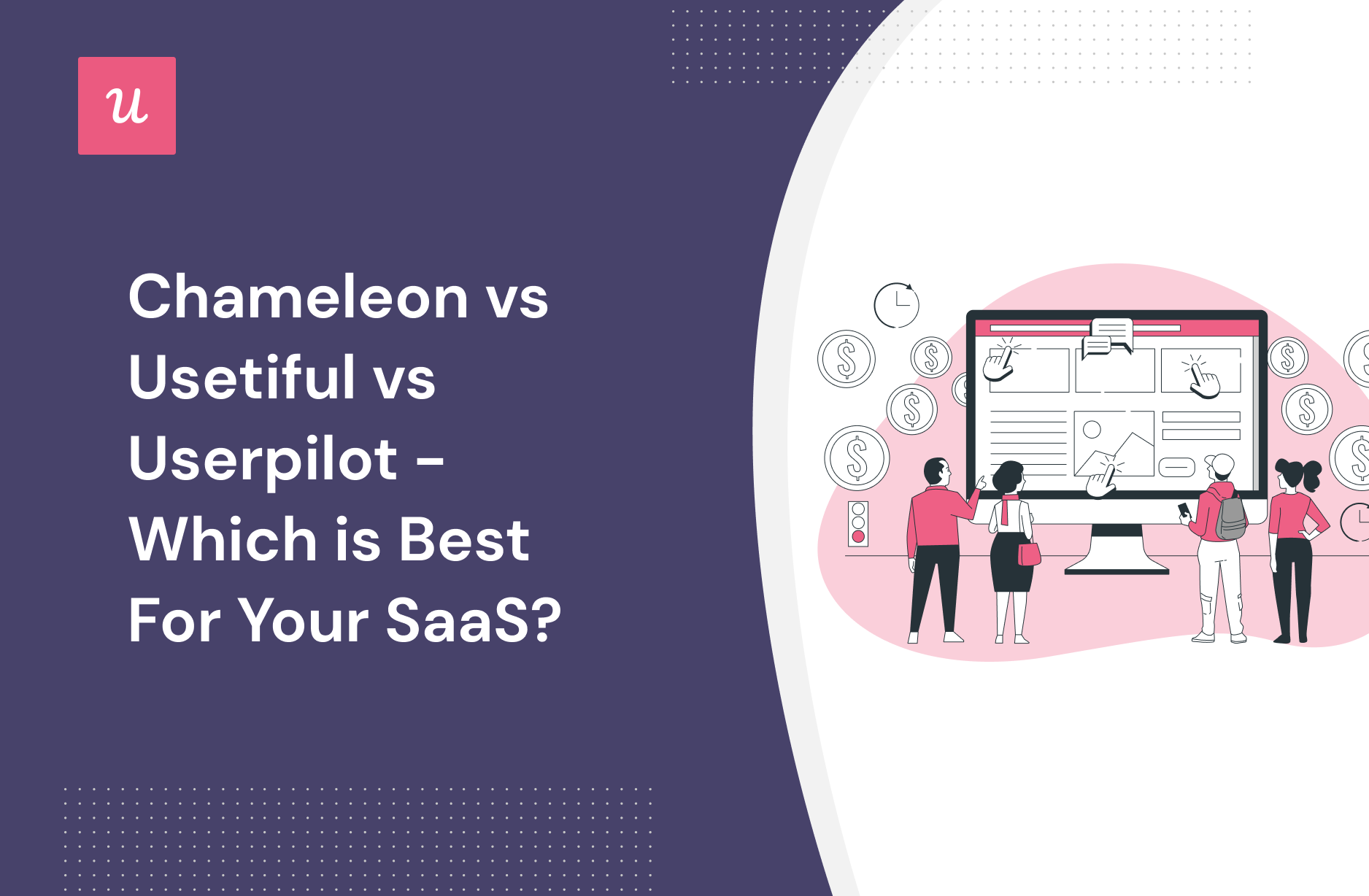
Deciding between Chameleon, Usetiful and Userpilot? We know that choosing the best product adoption platform for your SaaS is difficult. So we decided to write a more in-depth comparison of the three tools – going into more detail about the tools’ features, use cases, pros and cons – than what you’ll find on review sites.
Whether you’re looking mainly to improve your user onboarding or product analytics, collect user feedback or NPS – you’ll find out how Chameleon performs vs Usetiful vs Userpilot – and which one is the best choice for you!
Let’s dig in!
TL;DR
- Chameleon is a powerful and effective tool that works in a similar way to Userpilot and offers similar features: styling, analytics, templates, goals, A/B testing, and checklists. However, it doesn’t offer a resource center or dedicated NPS, and it’s a lot worse value for money with limited features in the basic plan, which is over $150 more expensive for the same number of MAUs.
- Usetiful is a cloud-based digital adoption platform focused on both employee and user onboarding that offers advanced onboarding features such as interactive guided tours, checklists, and smart hints that encourage users to engage with the product and drive them toward adoption.
- However, since it’s a fairly new tool you’ll encounter bugs and performance issues, and the lack of integrations might be a no-go for you.
- Userpilot is a comprehensive digital adoption platform (DAP). It enables product teams to track product usage and user behavior to guide product development and optimize the user experience. In addition, it allows them to gather user feedback with various survey templates and design personalized onboarding experiences to drive product adoption. All of this is possible without coding. Book a demo to learn more.
![]()
Comparing Chameleon vs Usetiful vs Userpilot? Try the best one FREE!

What is Chameleon?
Chameleon is a digital adoption platform with a difference: while the other tools discussed are mostly no-code, Chameleon will require some developer involvement.
Nevertheless, it’s a powerful and effective tool that works in a similar way to Userpilot and offers similar features: styling, analytics, templates, goals, A/B testing, and checklists.
However, it doesn’t offer a resource center, or dedicated NPS, and it’s a lot worse value for money with limited features in the basic plan, which is over $150 more expensive for the same number of MAUs.
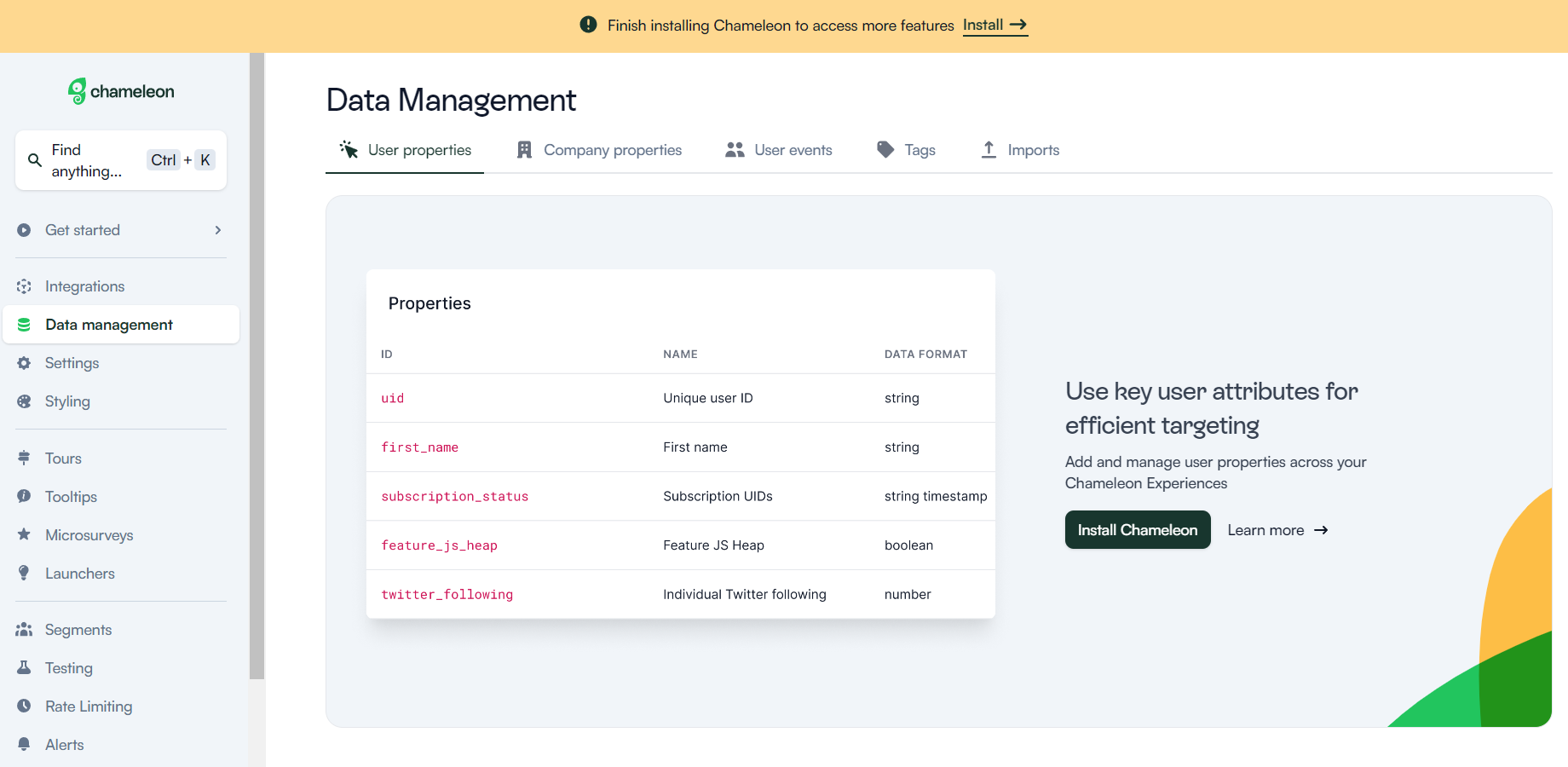
What is Chameleon best for?
Typically, SaaS Product Managers consider Chameleon for the following reasons: they want to improve their user onboarding, they need product adoption, and would also be able to measure their user feedback.
How does Chameleon perform when it comes to these top-three use cases? Let’s examine it all, and then compare it to the other tools we’re discussing in this post.
Chameleon for user onboarding
You can build widgets (launchers) and classic guides and tours with Chameleon as the main drivers of user onboarding.
Here’s how Chameleon’s main functionality helps with user onboarding:
- Chameleon’s product tours help you build flows for guidance. You can use several UI patterns for this: modals, banners, tooltips, and hotspots.
- You can customize the styling (font, color, opacity, etc) of your product tours and even add in some CSS styling if you want advanced branding.
- Launchers are where Chameleon is different compared to its competitors. These are in-app widgets that can open checklists, small help widgets, or notification centers. The downside is that you can’t have one launcher with multiple types of content.
- You can target content to different user segments based on multiple data sources including event triggering.
- Ability to use micro surveys with great customization and question-and-answer types.
- On Growth Plan and higher, you also get access to more functionality like A/B testing, multiple environments, localization (Enterprise plan only), and advanced integrations like Hubspot
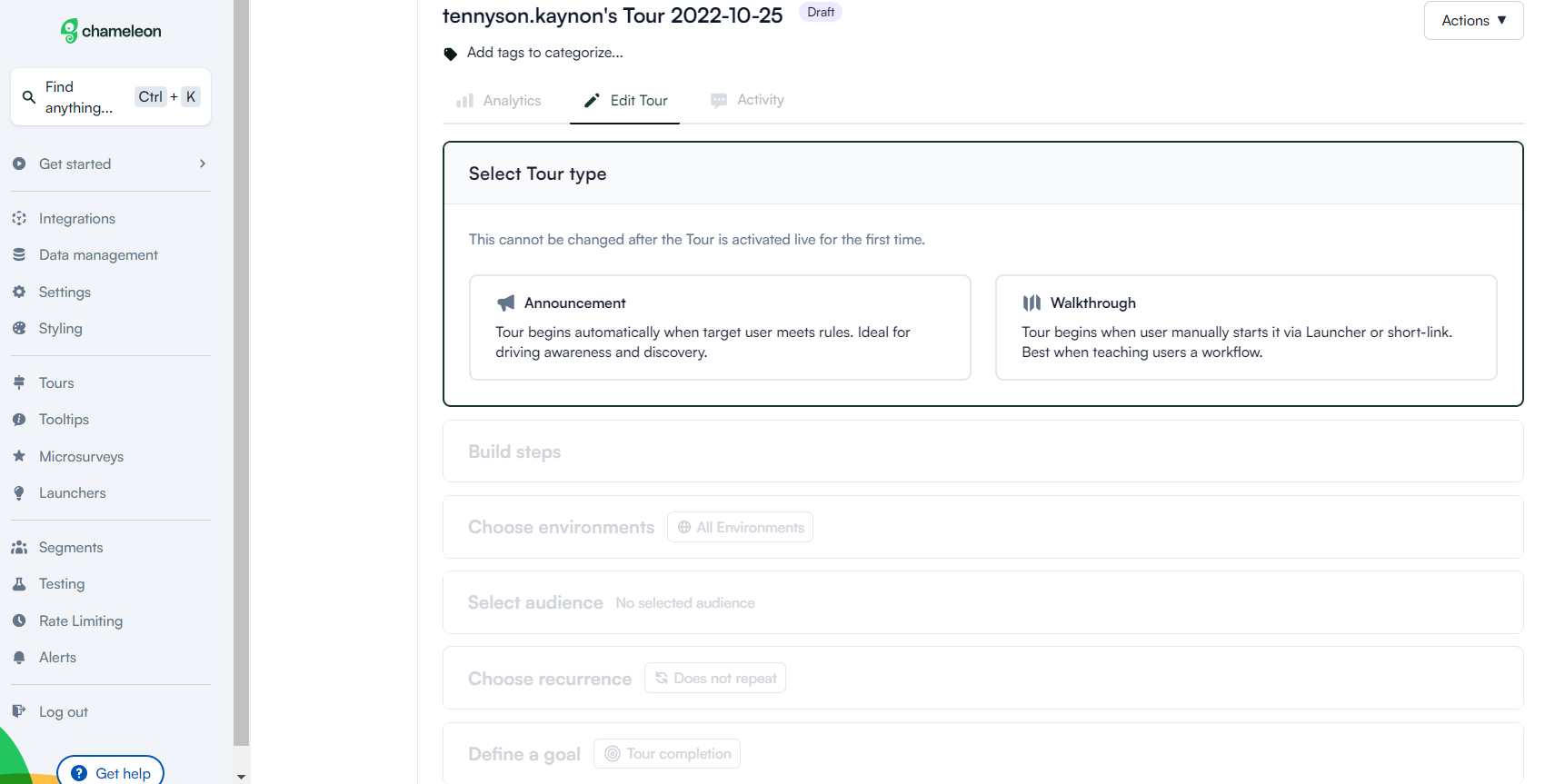
All in all, Chameleon has good functionality for user onboarding but will be very limited on the Startup plan as you only get one Launcher and five micro surveys.
To build contextual and efficient user onboarding you will need more than that. Considering what you get for the money, Userpilot offers much better value.
Chameleon for product adoption
Chameleon is a no-code solution for SaaS product adoption. It offers four key products:
-
Step-by-step tours: to guide users through the product
-
Self-serve launchers: for easy access to resources
-
Tips for unblocking users and giving best practices
-
In-product microsurveys: for gathering contextual feedback
By allowing you to personalize customer experiences, you’re able to create user flows that will lead to the successful adoption of your products.
Additionally, Chameleon offers highly customizable styling, allowing you to create experiences that look native rather than like external products.
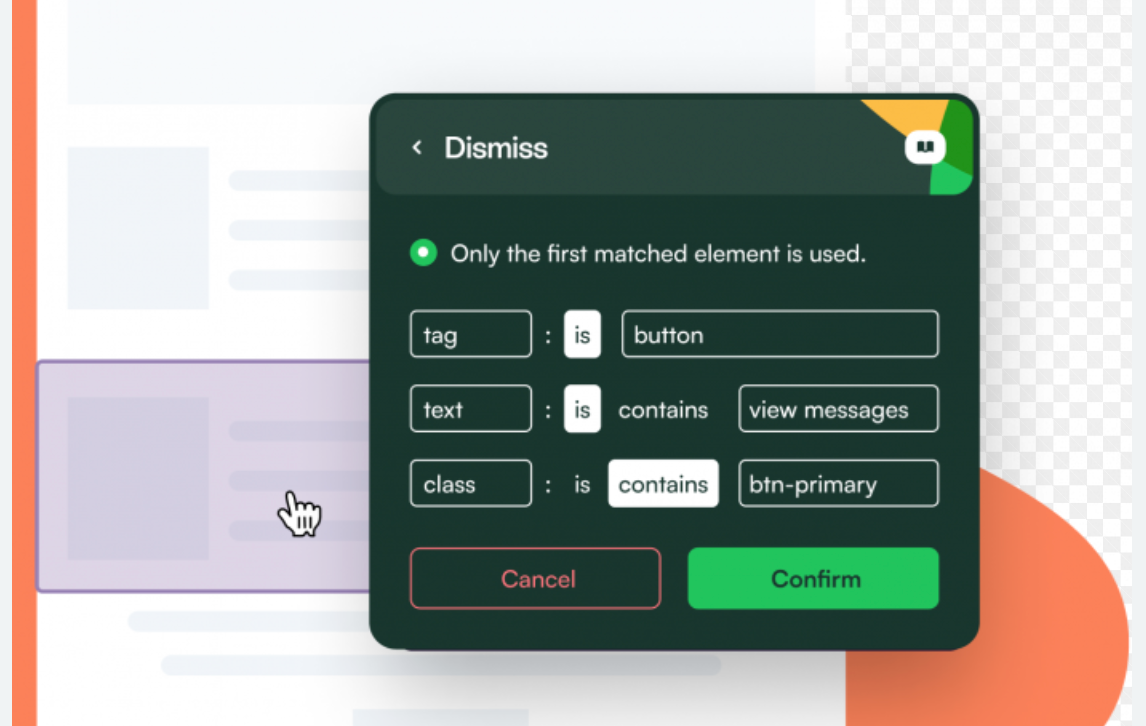
Chameleon for user feedback
Here’s how you can collect user feedback with Chameleon:
- Build different types of micro surveys (limited to 5 on the Startup plan) such as NPS, CSAT, CES, Opt-in, and custom feedback types.
- Personalize the surveys as you wish (you will need help from a developer or may require CSS skills).
- You can select the survey’s frequency and whether you want it to repeat.
- You get access to basic completion reports. Most of the additional data will need to be analyzed in your analytics tools that Chameleon integrates with and sends data to.
- You will see your NPS score in the reports but for the rest of the micro surveys, you will need analytics tools.
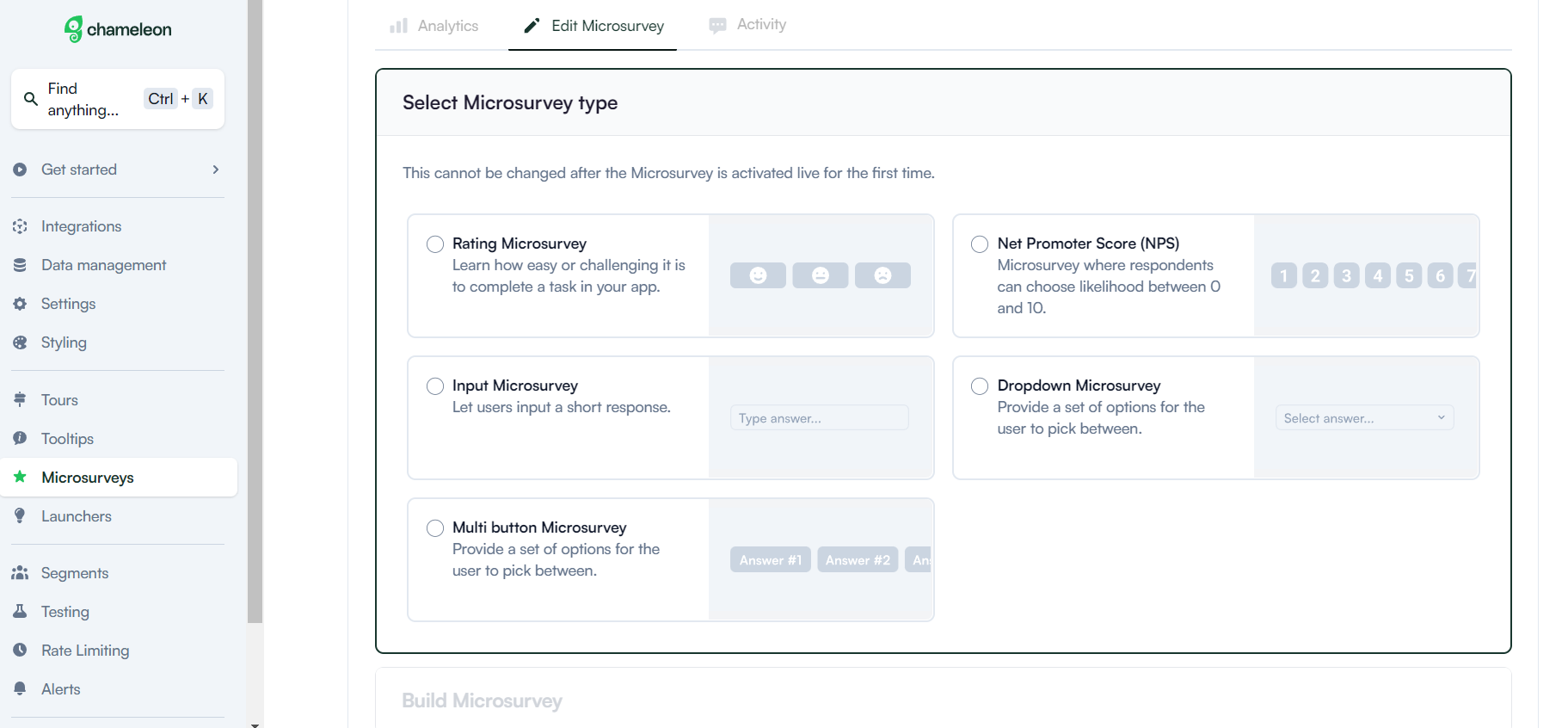
It’s great that Chameleon lets you build beautiful micro surveys but it might not be the best tool if you want to analyze the data and most importantly act on it.
For example, with Userpilot you can create custom user segments based on survey responses or NPS scores and trigger specific in-app flows for them.
![]()
There is a better tool for your SaaS than Chameleon!

What is Usetiful?
Usetiful is a cloud-based digital adoption platform focused on both employee and user onboarding.
The tool offers advanced onboarding features such as interactive guided tours, checklists, and smart hints that encourage users to engage with the product and drive them toward adoption.
Usertiful is especially praised by its customers for having a simplistic, user-friendly design and a helpful customer support team.
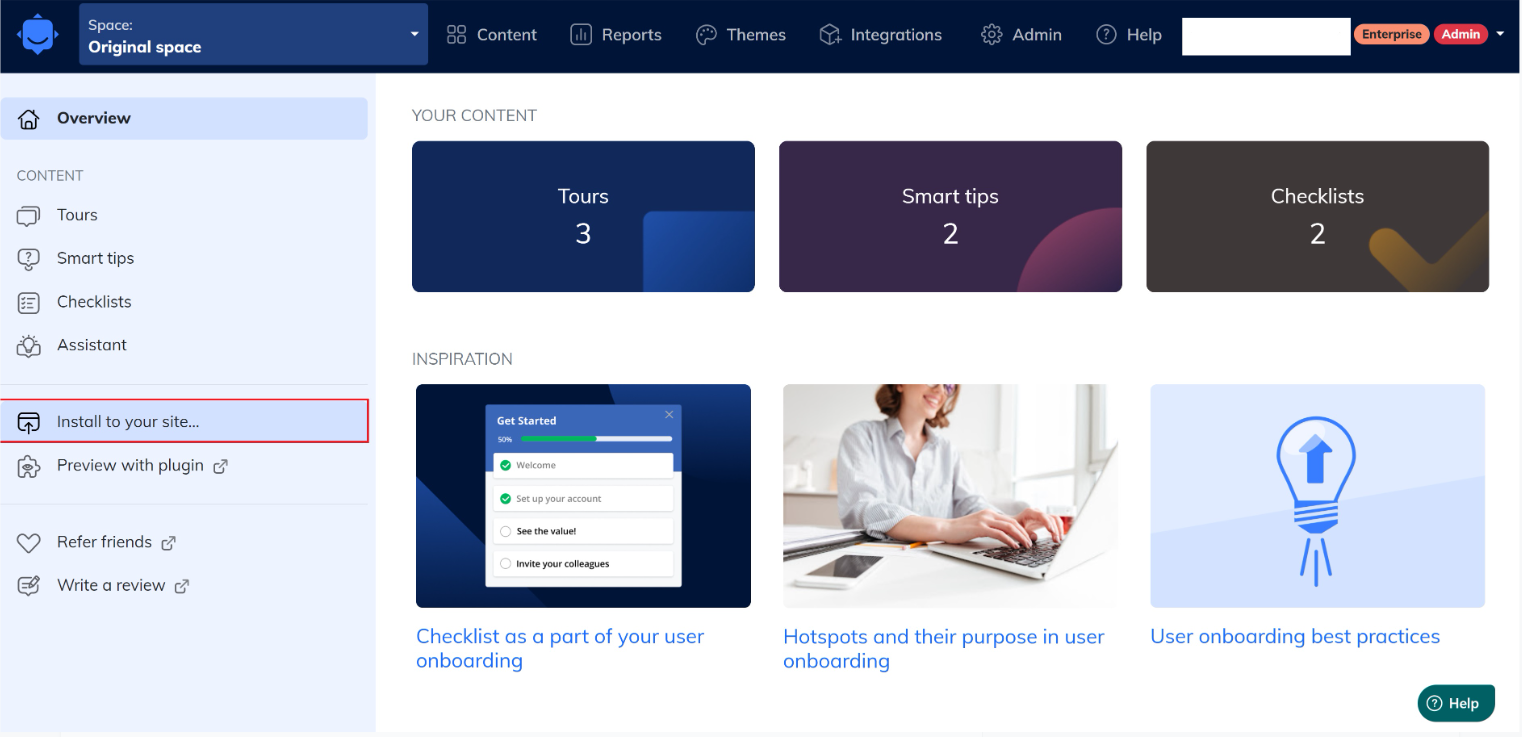
What is Usetiful best for?
Similar to Chameleon, Usetiful is typically considered for user onboarding, product adoption, and user feedback. Let’s examine Usetiful for these use cases before we compare it to Userpilot.
Usetiful for user onboarding
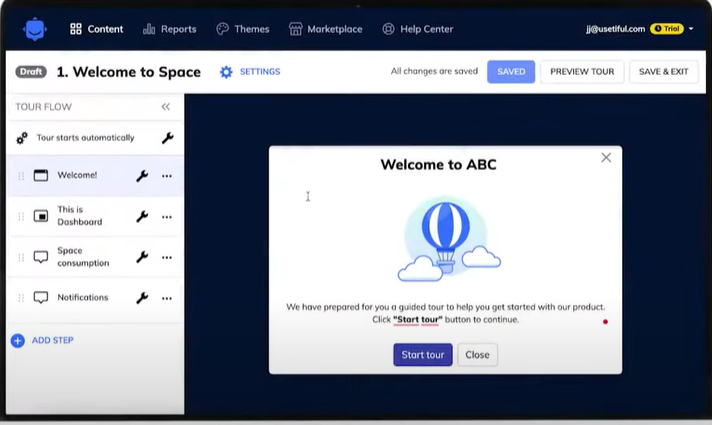
Here’s how Usetiful can help with user onboarding:
- Create onboarding checklists that drive users toward key actions and accelerate activation.
- Design interactive product tours that embrace the learn-by-doing approach and teach how to use a feature step-by-step. You can incorporate different UI elements into walkthroughs such as tip balloons, pointers, modals, and slideouts. Either customize the available templates or use the WYSIWYG (what-you-see-is-what-you-get) visual design studio editor for creating original designs from scratch.
- Segment customers based on attributes like role, language, status, etc, and target them with tailored onboarding experiences that deliver the promised value fast.
- Provide in-app guidance using Smart Tips. Those are similar to tooltips in their anatomy but unlike tooltips, which mainly highlight relevant features and engage users with them, Smart Tips are more geared towards reducing friction and preventing user errors. For instance, you can add Smart Tips to forms and provide additional instructions on how to successfully fill them out.
Usetiful for product adoption
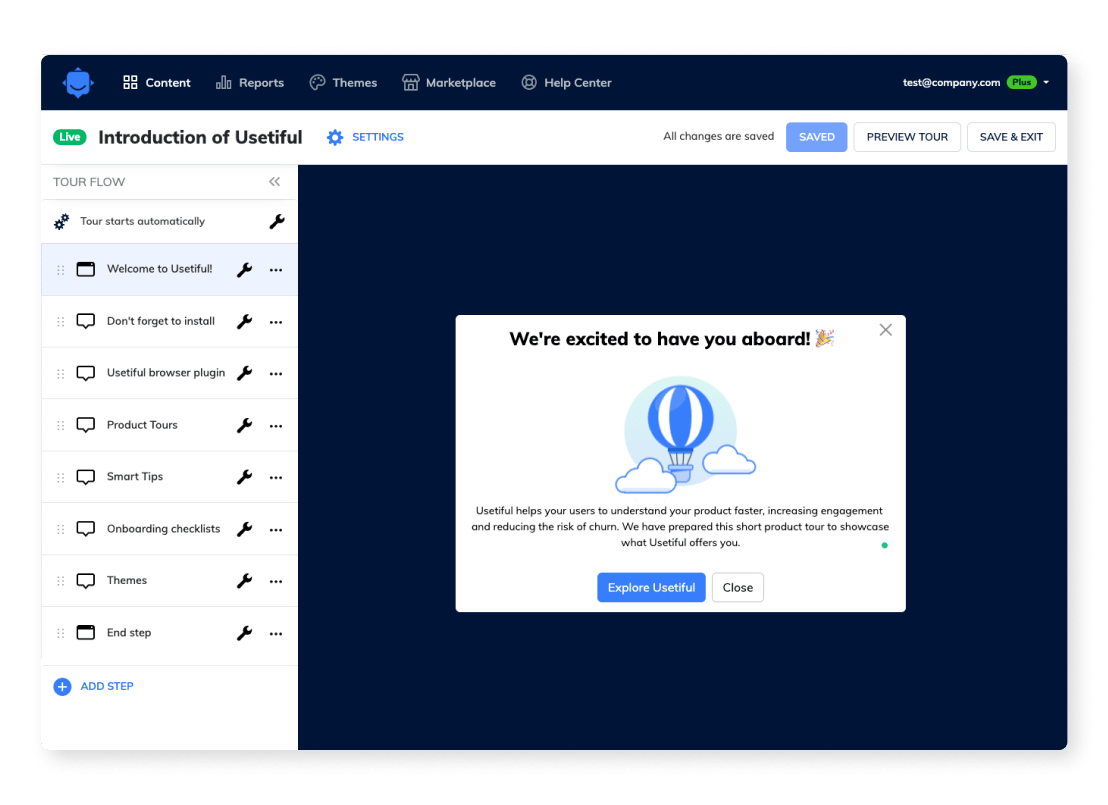
Usetiful describes itself as a tool aiming to bridge the gap between users and digital systems, so it’s no surprise that it comes with powerful product adoption features. Here’s how Usetiful functionalities can help you drive adoption:
- Create onboarding checklists that list the most important steps users must take in order to experience value. You can even gamify the checklists and add progress bars to motivate users to complete them.
- Design interactive guides that teach customers how to use a feature step-by-step. You can either use a friendly Chrome extension or a visual editor inside Usetiful to build those tours effortlessly.
- Reduce adoption friction with in-app messages called Smart Tips. Those are advanced tooltips that prevent user errors and smoothen the adoption experience by providing additional information and guidance wherever the user needs it.
If you are a small startup looking to build simple in-app flows and experiences, Usetiful is a great fit.
However, if your product is complex and you want to create more sophisticated and customized flows, this might not be for you.
Usetiful for user feedback
Usetiful doesn’t support native in-app surveys, but its integration with Survio makes in-product feedback collection possible. You have to register and create a survey in Survio, then copy the code and past it into Usetiful’s flow builder. Then you can:
- Trigger survey flows to specific user segments.
- Collect feedback on product tours and continuously improve them.
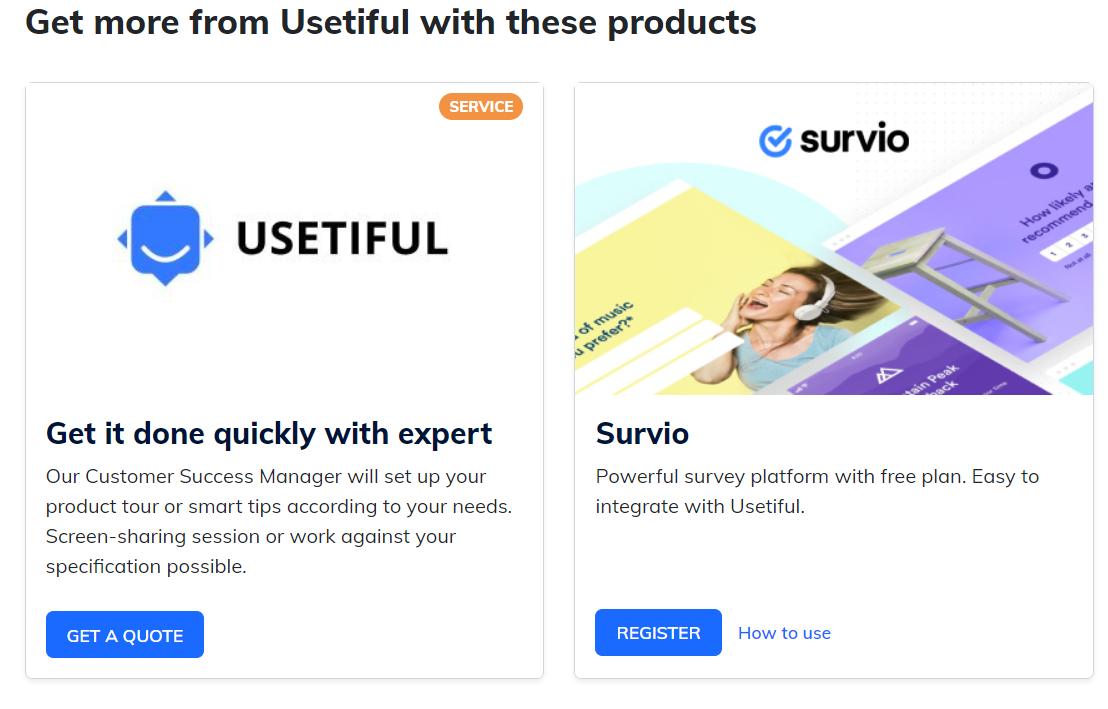
Based on the above, when it comes to user feedback, Usetiful isn’t a great tool, as it lacks the ability to create surveys directly within the app and segment users based on survey responses to deliver tailored experiences.
![]()
Try a better tool for your SaaS than Usetiful!

What is Userpilot?
Userpilot is a comprehensive digital adoption platform (DAP). It enables product teams to track product usage and user behavior to guide product development and optimize the user experience.
In addition, it allows them to gather user feedback and design personalized onboarding experiences to drive product adoption. All of this is possible without coding.

What is Userpilot best for?
Userpilot is used for similar use cases as Usetiful and Chameleon.
Let’s see how Userpilot compares to the tools we discussed before it comes to user onboarding, product adoption, and user feedback.
Userpilot for user onboarding
Userpilot was built specifically for SaaS product teams that want to improve their user onboarding experience and boost user activation.
You can build a huge variety of user onboarding experiences and in-app guidance flows without needing to code.
Here’s what you’ll get when you start using Userpilot:
- Forget about coding in-app experiences: Userpilot is a no-code solution and only requires your dev to install a line of javascript inside your app and for you to download a Chrome extension that opens up the visual builder.
- Build in-app flows using the largest range of UI patterns (modals, slideouts, tooltips, hotspots, banners) and in-app onboarding experiences (checklists, micro surveys, NPS surveys, in-app resource center).
- Use AI assistant to enhance your micro copy and drive engagement.
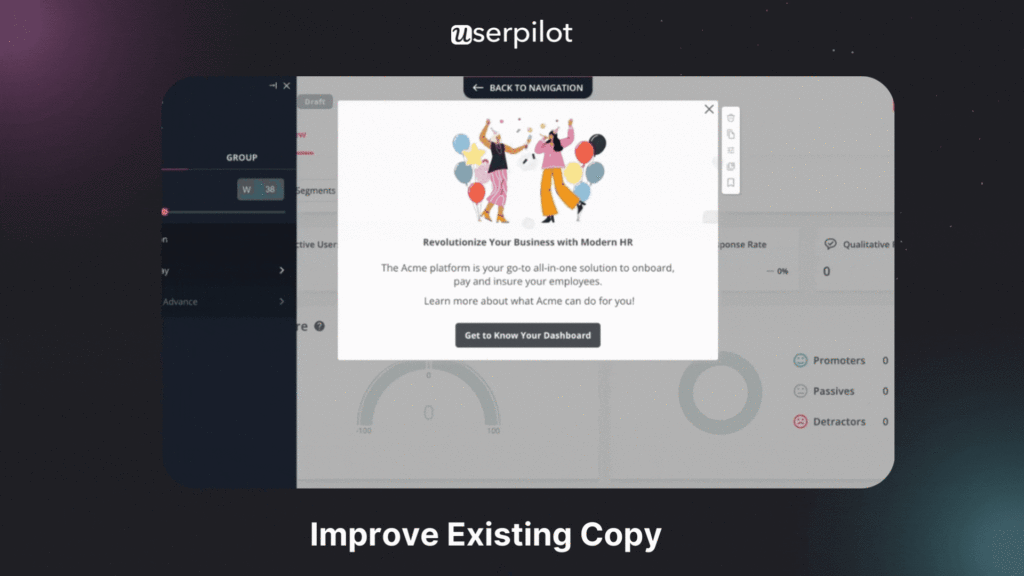
- Get access to a built-in NPS tool for collecting and analyzing user sentiment so you can improve your onboarding process based on real data.
- Create and track combinations of in-app events like clicks, hovers, and form fills, and then analyze all these interactions under your own custom events, which can be built without code or API calls.
- Use advanced product analytics and in-app flows analytics to identify where users need help and create granular user segments to trigger in-app experiences contextually (segment based on user identification data, in-app engagement, custom events, clicks, hovers, form fills, user feedback responses, NPS scores and more).
- Enhance the onboarding experience with in-app help by launching a Resource Center directly inside your app. Add in-app guides, and video tutorials, and give users access to search the knowledge base or reach out to support. Self-service has never been easier.
The best user onboarding is contextual and it happens right where the users need it, inside your app. There isn’t a better user onboarding tool out there that offers more value for the money than Userpilot.
Schedule a demo with our team and get ready to build the best onboarding experiences your users have seen.
Userpilot for product adoption
Product adoption describes the process of getting users to the point where they are experiencing value from your product.
Userpilot is a powerful product adoption platform that enables you to quickly build personalized and contextual in-app experiences targeted to different user experiences – all without writing a line of code.
It’s a great option for enterprise users too since it’s SOC 2 Type II certified and offers robust features for large-scale usage.
You get access to advanced product adoption analytics so you know which features bring more value to users.
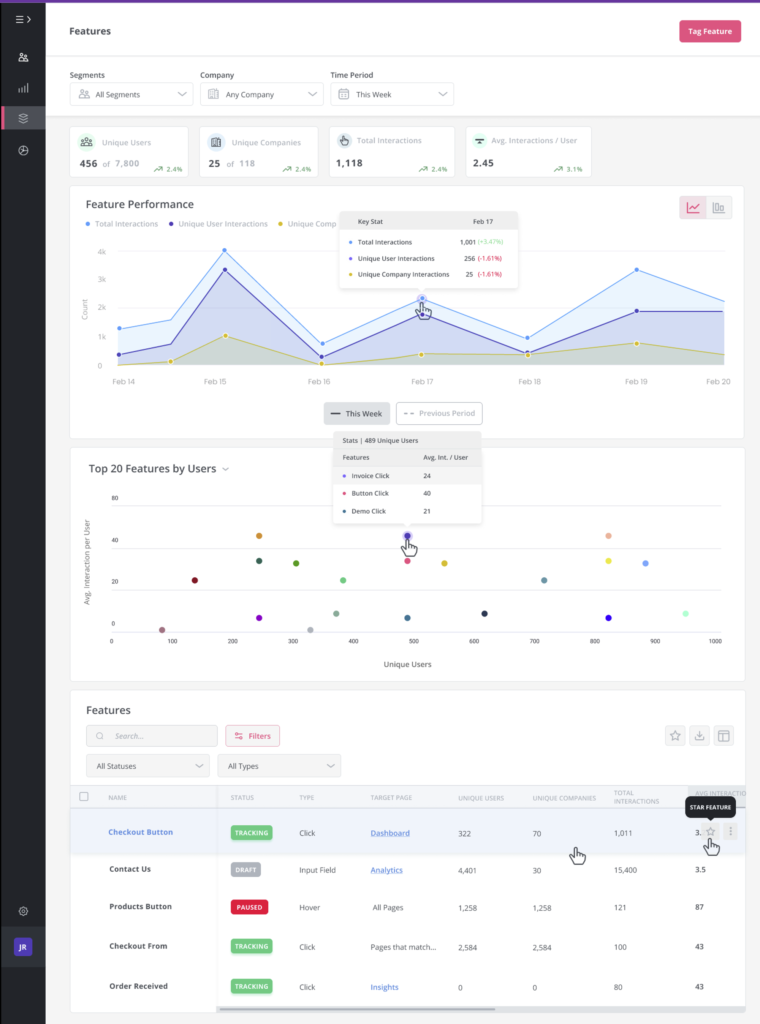
Here are some of Userpilot’s product adoption features that you may find helpful:
- A broad range of UI patterns to build fully customizable, contextual, and interactive in-app flows: modals, slideouts, tooltips, hotspots, driven actions, banners, and more. And – most importantly – you are not limited by plan when it comes to how many UI patterns or designs you can build.
- Advanced in-app checklists with built-in gamification elements like progress bars or ”automatically marked complete” tasks: checklists also come with analytics so you can track who is interacting with them and how.
- Fully interactive walkthroughs walk users through engaging and adopting specific features of your app.
- The self-service in-app resource center lets users search your knowledge base directly inside the app, access chat, and support but also launch guides and tutorials when they get stuck.
- User feedback tools allow you to collect insights to improve the product and the user experience, thus leading to a higher product adoption rate. You can also collect NPS data and tag responses to uncover patterns into what makes users stick, or build micro surveys for more granular data. Then you can use all the feedback collected to build user segments based on the answers and personalize the path to higher product adoption for each segment.
Want to see Userpilot in action? Get a demo and improve product adoption with contextual and personalized in-app flows that actually help users.
Userpilot for user feedback
There are two types of feedback you should be focusing on collecting to better understand the health of your product and users.
First, you have user sentiment which looks at user satisfaction and effort scores or loyalty (using NPS surveys). Then you may also want to collect feedback on the functionality of the product or specific features.
You can do all these with Userpilot. In short, you can:
- Collect and track (NPS) in-app with a built-in NPS widget that allows you to fully customize the survey look and feel, and set the trigger frequency and specific targeting.
- Analyze NPS scores, tag responses, and use the data to create specific user segments.
- Build and trigger in-app micro surveys like the classic PMF survey, or similar ones and mix multi-choice and open-ended types of questions to collect specific insights.
- Be in charge of who gets which survey type and when with advanced segmentation capabilities, and of course, you can use the answers to segment your audience.
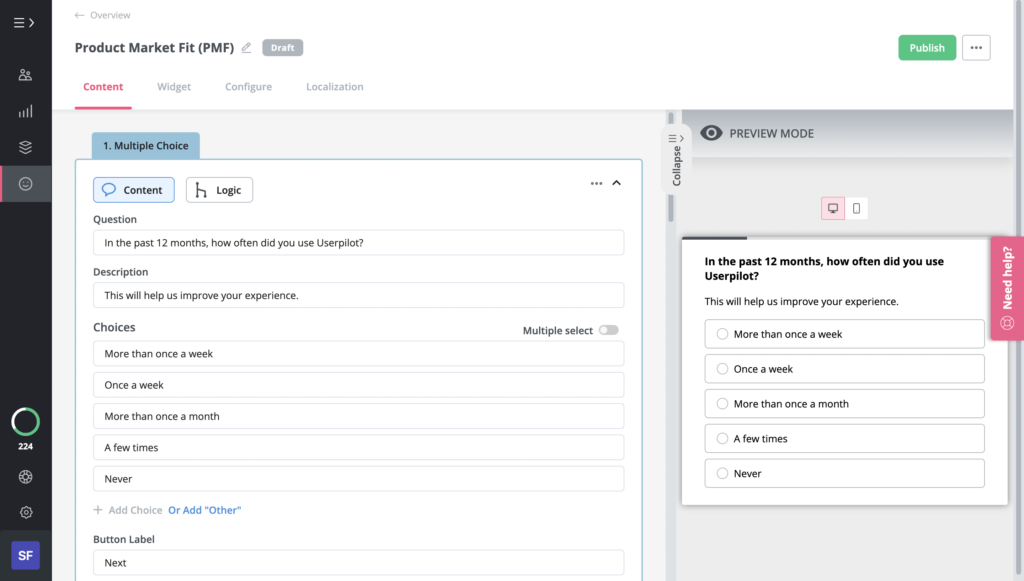
The advantage of using Userpilot for collecting feedback over other survey tools is that you can better control who sees the surveys but also you can instantly use the data collected to segment your user base and trigger the right experience for them.
For instance, if your users give you a low NPS score because they think you’re missing a critical feature (that you actually have already), you can push an interactive walkthrough guiding them to find and explore this feature.
![]()
Tired of bad Digital Adoption tools? Try Userpilot for your SaaS for free!

So Which tool should you choose? Chameleon vs Usetiful vs Userpilot – final thoughts
As you can see, both Chameleon, Usetiful, and Userpilot cater to most of the use cases Product Managers typically look for in their SaaS companies.
There are some differences between the tools when it comes to how those use cases are executed in each, of course. So if you’re still on the fence – there are two more factors that can make a difference for you – the tools’ pricing, and its reviews.
Let’s have a look at both below!
Chameleon pricing
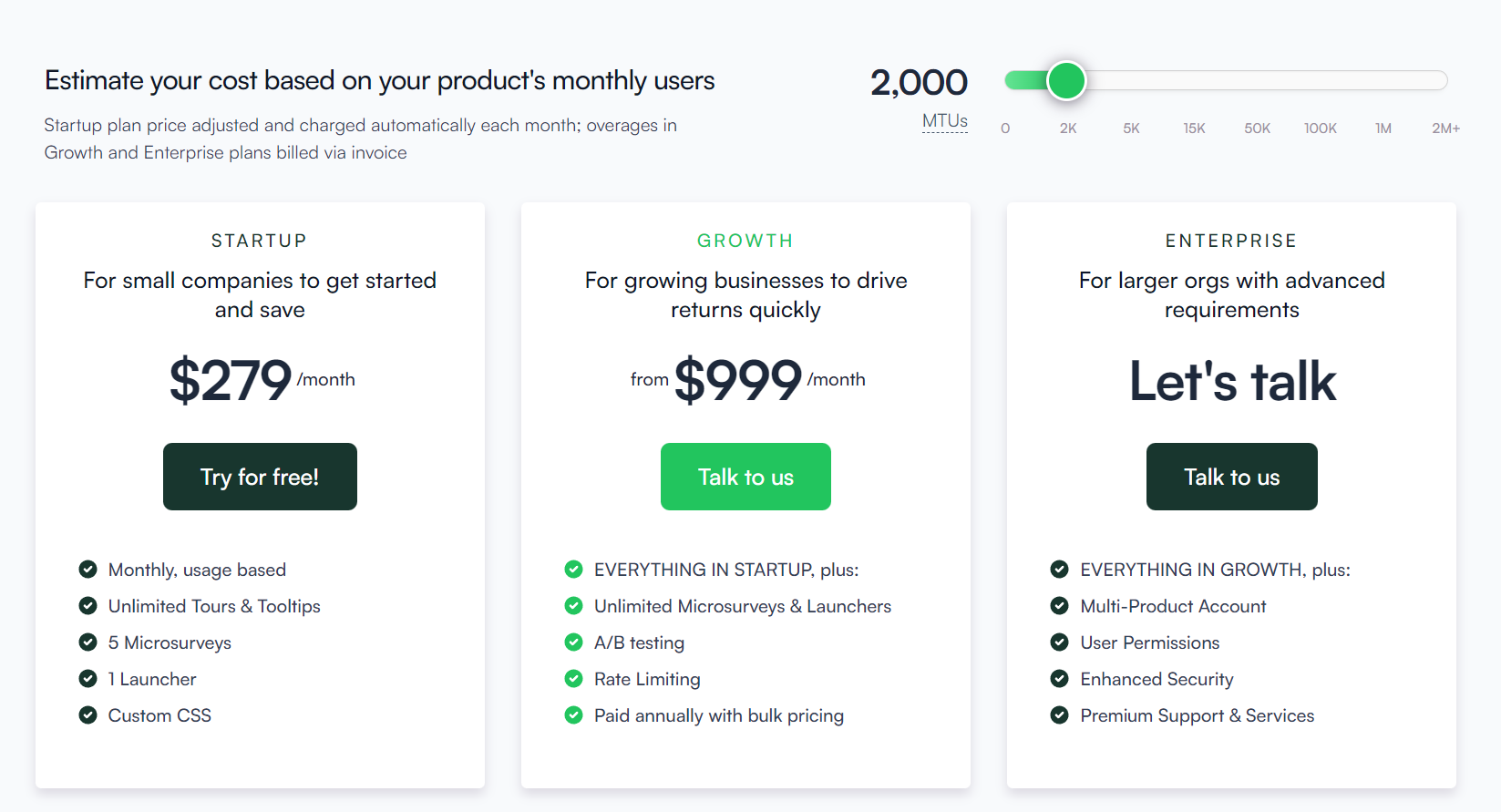
Chameleon split their pricing options primarily by the number of monthly active users, but you should keep in mind that the Startup plan also has limited features and might not be enough for interactive user onboarding and adoption for SaaS products:
- 0 – 2500 MAUs: Startup plan from $349/mo, Growth plan from $1249/mo
- 2000 – 3000MAUs: Startup plan from $419/mo, Growth from $1299/mo.
- 3000 – 5000 MAUs: Startup plan from $489/mo, Growth from $1449/mo.
- 5000 – 10,000 MAUs: Startup plan from $629/mo, Growth from $1749/mo
Disclaimer: with the Startup plan you only get 5 microsurveys and 1 launcher, no A/B testing, no Goals, and no localization.
Usetiful pricing
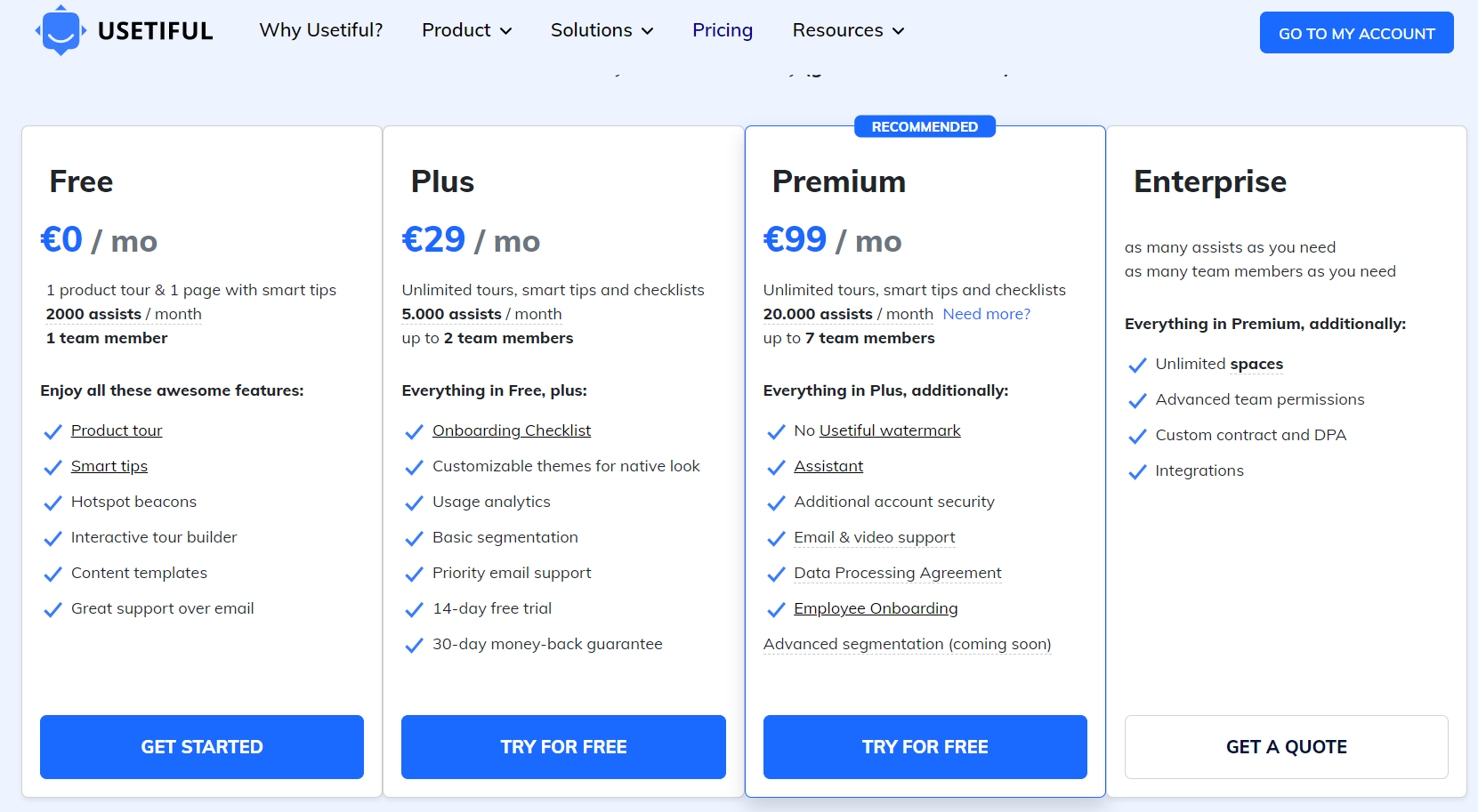
Usertiful offers straightforward pricing plans. There are four tiers, each charging a set amount for access to certain features.
- Free: allows you to create one product tour and multiple smart tips across 1 URL.
- Plus – €29/month: includes unlimited product tours, smart tips and checklists, access to usage analytics, and basic segmentation features.
- Premium – €99/month: create designs without Usetiful watermark, build more sophisticated segments and access tools for employee onboarding.
- Enterprise: everything in Premium plus run Usetiful on multiple products and environments.
Userpilot pricing
Userpilot offers great value for money compared to other similar tools on the market. Even its entry-level plan (Traction) provides all the necessary features without any usage limit.
The price-to-feature ratio is the best for Userpilot. Other cheaper tools in the market would definitely not fulfill your needs, and others like Pendo would be out of budget. Userpilot sits in that sweet spot. – Saurav S.
The pricing differentiation happens mostly on the service level (e.g. custom domain hosting, dedicated Customer Success Manager, SLA) and is based on the number of Monthly Active Users (MAUs) your company has.
Here’s the detailed Userpilot pricing:
- Traction: For up to 2500 users, this plan is $249/ mo.
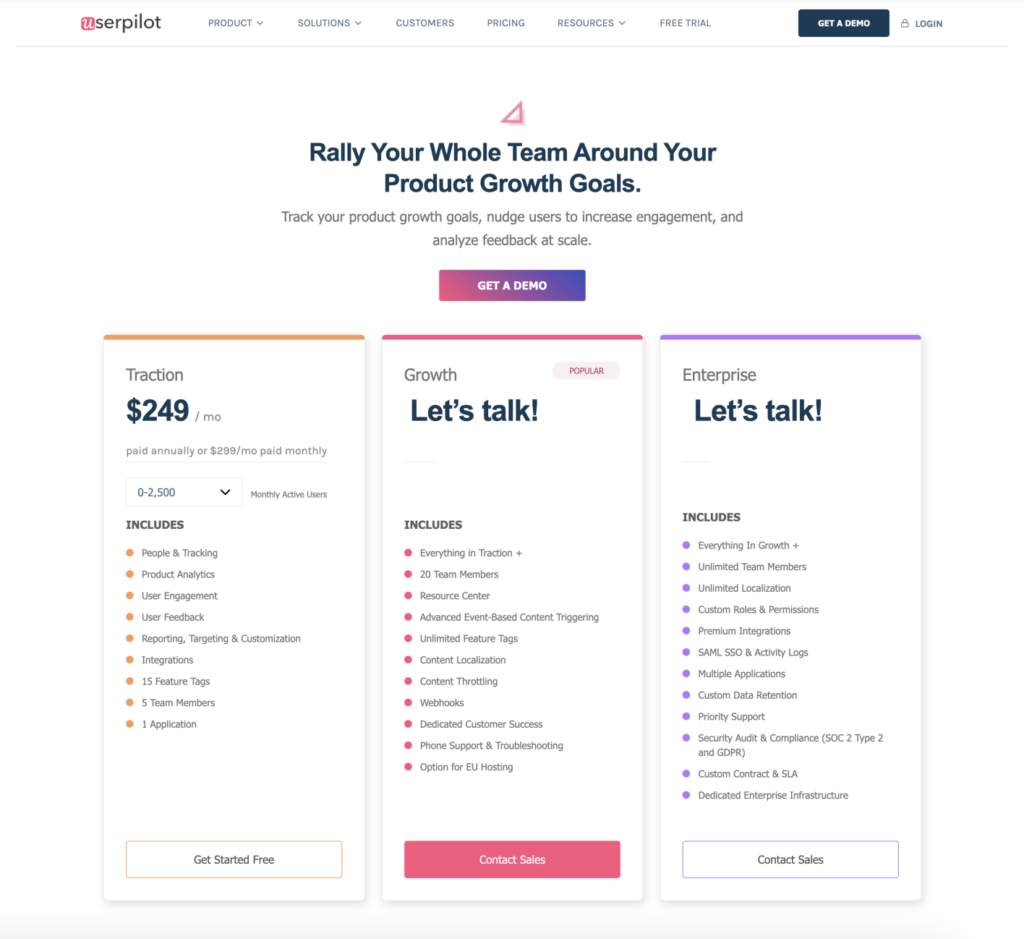
What do users say about Chameleon vs Usetiful vs Userpilot?
Chameleon reviews
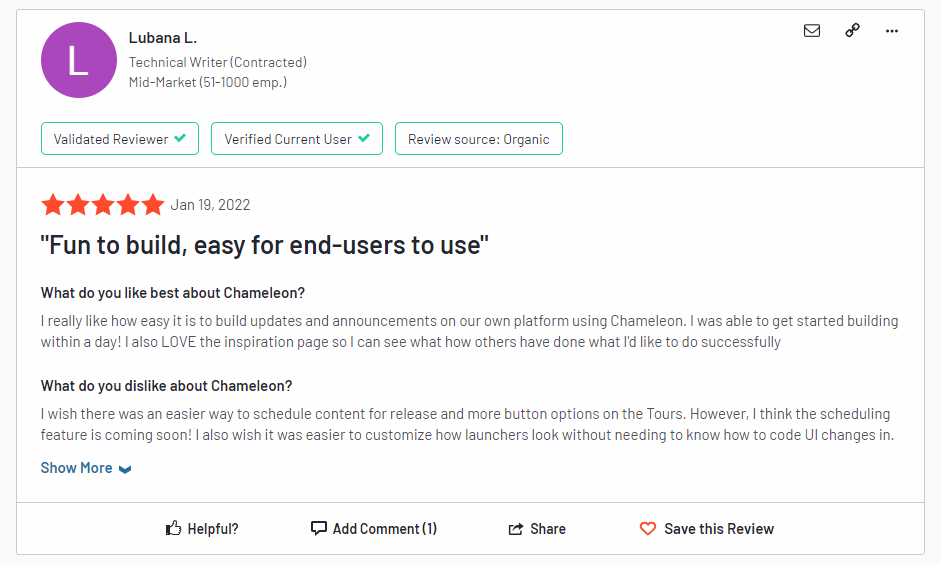
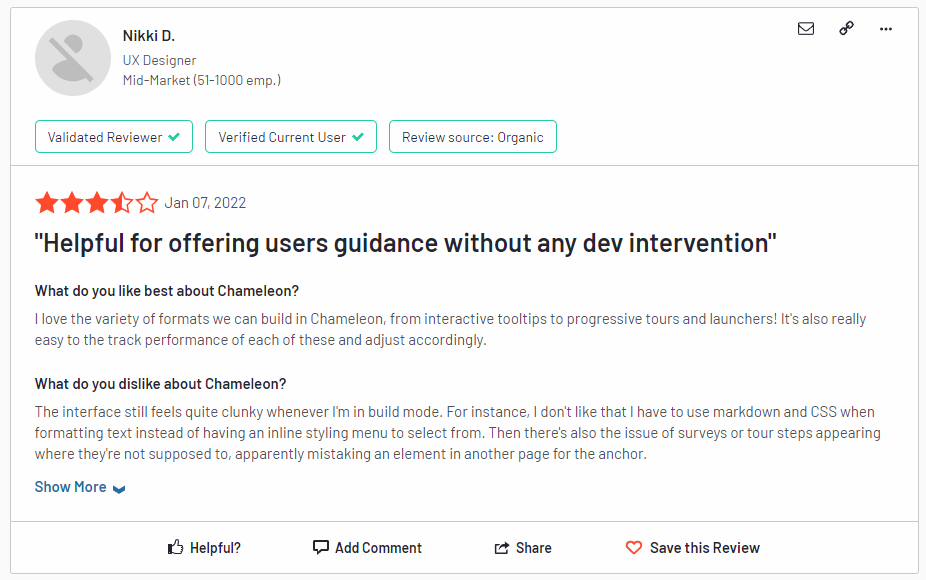
Usetiful reviews
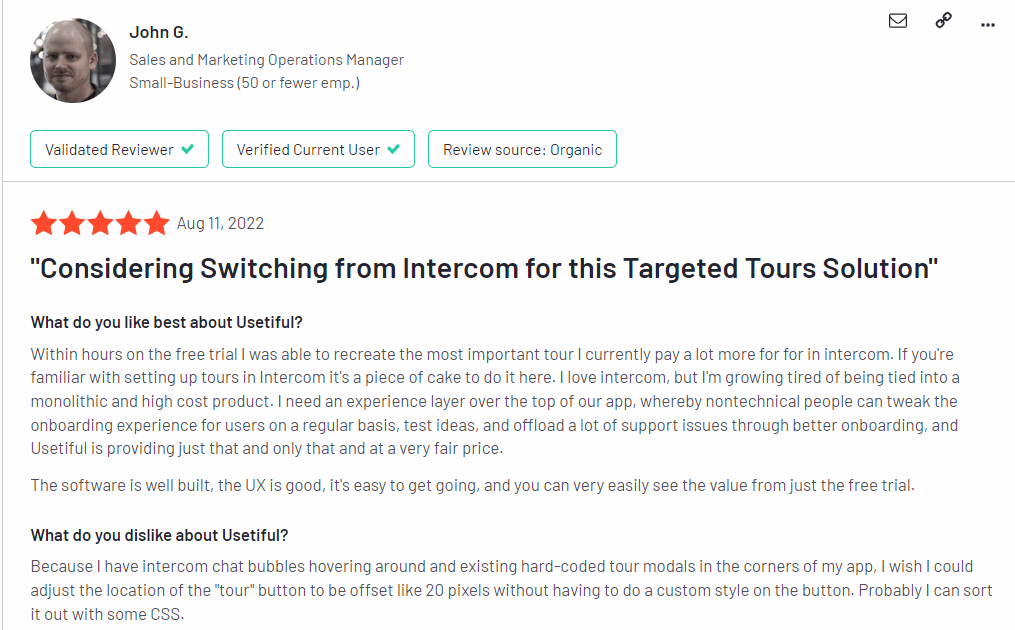
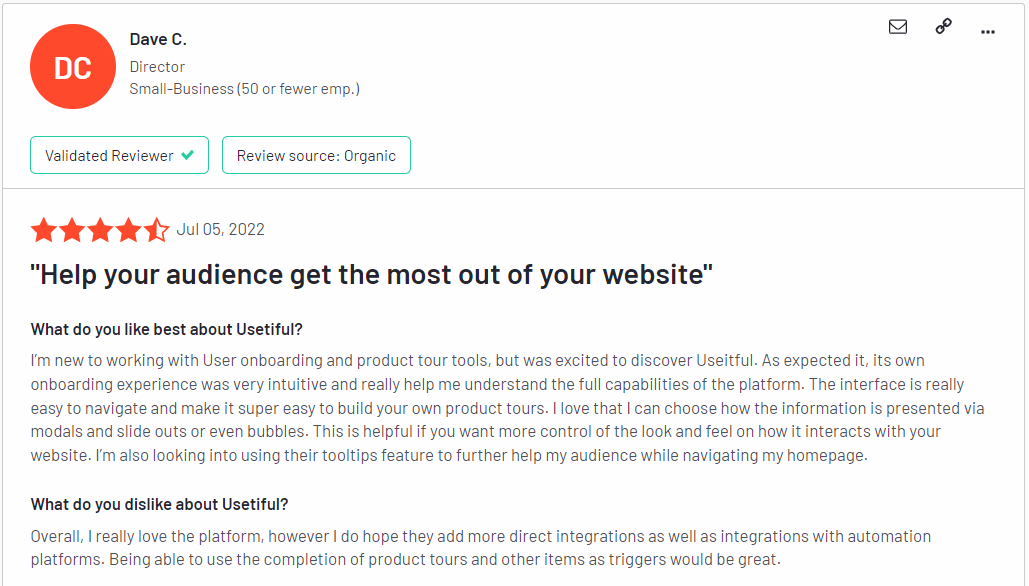
Userpilot reviews

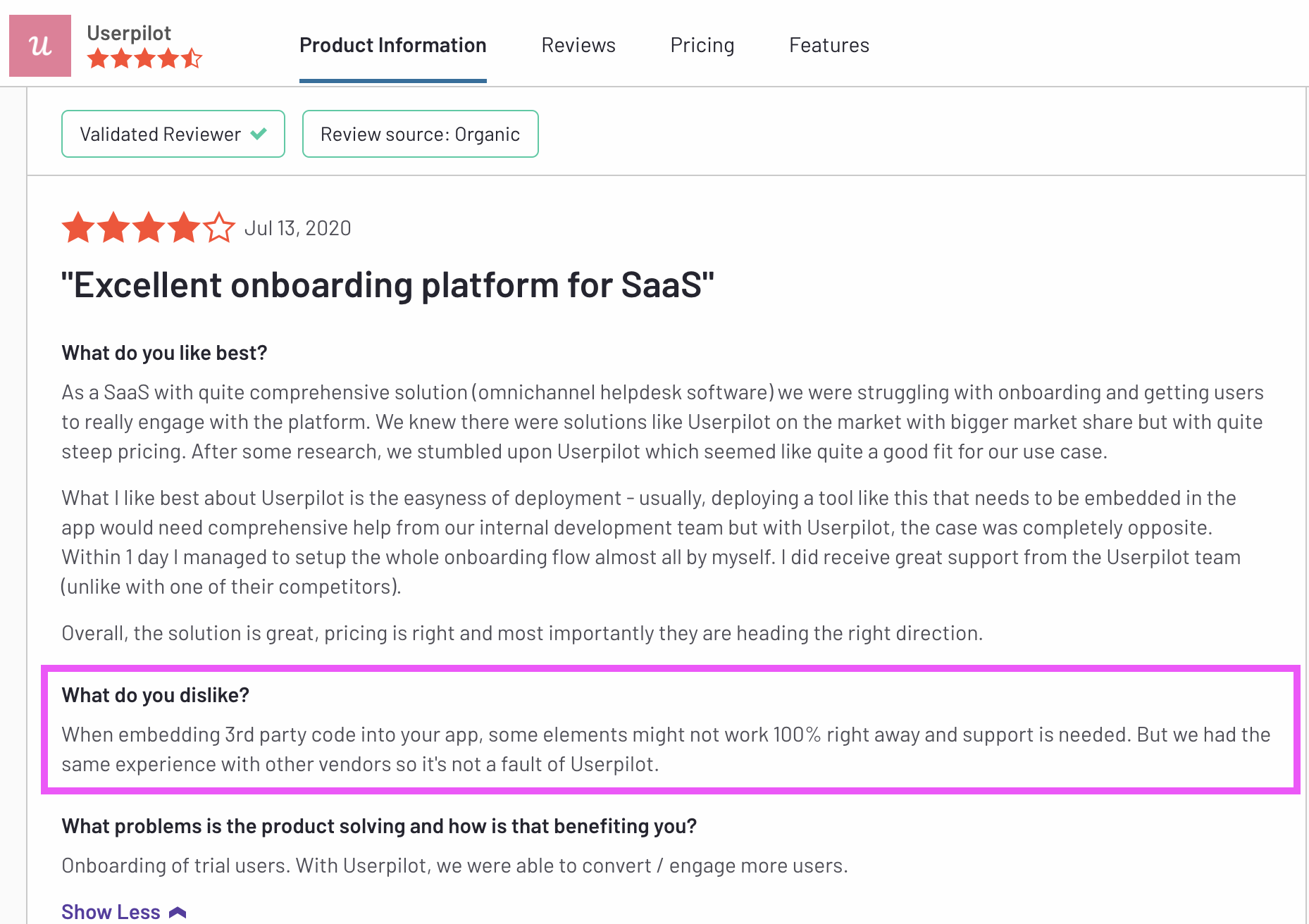
The final countdown: Pros & Cons of Chameleon, Usetiful and Userpilot
Chameleon pros
Chameleon is a robust tool for your onboarding and adoption needs. Here are the main pros to consider if you’re still deciding:
- Offers a good range of in-app messaging and UI patterns. You can create custom modals, slideouts, tooltips, hotspots, launchers (checklists or resource hub), and more.
- Good segmentation options, you can either build different user segments inside the product, or you can integrate your Chameleon account with other tools and import your data.
- Can be used on 3rd party tools, meaning you can use it for employee onboarding too.
- Offers a good range of two-way integrations: Mixpanel, Segment, Intercom, Customer.io, Segment, Hubspot etc.
Chameleon cons
While Chameleon is a great tool, the main downside is the cost and restrictions you get with it. Here are the main cons of the tool:
- There are some limitations to user onboarding flows. You can’t run multiple in-app experiences at the same time, as you can in Userpilot. Instead, Chameleon enables you to create user onboarding campaigns (different sequences of product tours shown over time).
- It’s built for single-page apps: Chameleon can’t build flows that run over multiple URLs.
- Doesn’t offer a self-service resource center where users can access multiple guides and tutorials or contact support. It does provide launchers that are similar but more restricted. A launcher can be a checklist or a list of resources, but can’t be both.
- It has a steeper learning curve and it’s not a completely no-code tool.
- The Startup (starter) plan is quite restrictive and expensive (starts at $349/mo for 2500 MAU and includes 1 Launcher only and 5 micro surveys). You will need to go for Growth ($1249/mo) if you want to drive product adoption.
Usetiful pros
Usetiful is an effective tool for streamlining your onboarding and adoption processes. If you are still weighing your options, here are some benefits to consider:
- The software works with your own and third-party tools alike, meaning it can be used for both customer and employee onboarding.
- Usetiful comes with an easy-to-use Chrome Extension builder that sits on top of your app and enables even non-technical team members to design functional onboarding flows within minutes.
- With Usetiful, you can leverage segmentation to deliver personalized onboarding experiences for your customers.
- Free plan and affordable pricing make it an excellent choice for small businesses and startups.
Usetiful cons
Usetiful, like any other app, has its own downsides and flaws. Here are the main cons of Usetiful:
- Since it’s a relatively new tool, you’ll encounter some bugs and performance issues when using it.
- Customization options are limited with colors and fonts. This can be frustrating for established companies that want to have complete control over the look and feel of onboarding UX patterns.
- Web apps only – Usetiful doesn’t work on mobile devices/applications.
- You can’t launch a self-service resource center where users can access multiple types of guides and tutorials
- Usetiful has almost no built-in integrations with other tools, although it does have webhooks.
Userpilot pros
Userpilot has a number of advantages, especially for mid-market SaaS companies looking for a robust but at the same time very easy-to-use, no-code tool for user onboarding, product adoption, and simplified product analytics. Let’s have a look at the pros of using Userpilot:
- No-code builder – Userpilot comes with an easy-to-use Chrome Extension builder.
- Multiple UI patterns – choose from a range of options to build customized flows: modals, slideouts, banners, tooltips, hotspots, and checklists are all at your disposal
- UI patterns are not limited by plan – you get access to all of them on every single plan, meaning you get value even with the Traction plan (this is the entry-level one).
- Engaging walkthroughs and onboarding flows- build interactive walkthroughs targeted to distinct user segments.
- In-app help – build a resource center offering self-service support to your users, customize it with your branding, and select from a range of help options to boost user satisfaction (i.e. videos, in-app flows, chat, and more).
- Experimentation – built-in A/B testing for flows lets you explore and quickly iterate based on direct user behavior.
- Powerful feedback options- integrated NPS surveys with analytics and response tagging unlock insight into how your users feel.
- Advanced analytics and segmentation- analyze product usage and in-app flow engagement and build user segments using the data.
- Event tracking and feature tags- tag UI engagement (clicks, form fills, hovers) and group them into one custom event to track what really matters.
- More value with integrations- unlock value faster with built-in integrations with popular tools like Segment, Amplitude, Mixpanel, Kissmetrics, Intercom, Heap, and more.
Userpilot cons
There are, however, some downsides to Userpilot as well:
- Browser/web app only – Userpilot won’t run on mobile devices/applications.
- Doesn’t support employee onboarding- The tool is better suited for customer onboarding than for employee onboarding as you can’t build in-app guides on third-party tools.
- Missing integrations – doesn’t have built-in integrations with some tools, but it has webhooks, and Hubspot and Zapier are coming soon.
- Not appropriate for small startups on a shoestring budget (<$100)- Userpilot is a powerful, mid-market to enterprise-level tool. So $249 a month might be too expensive for really small startups.
![]()
Try the best tool for user onboarding for FREE!

Conclusion
In this post, we’ve discussed how Chameleon, Usetiful and Userpilot compare when it comes to user onboarding, product adoption, and user feedback.
We’ve discussed their features for each use case, pricing, and reviews, as well as the pros and cons.
Hopefully, you’ve found these detailed descriptions helpful. Obviously, we’re a little biased, but we think that Userpilot offers the best value for money, and is unrivaled especially when it comes to user onboarding. Get a Userpilot demo and test it out.

